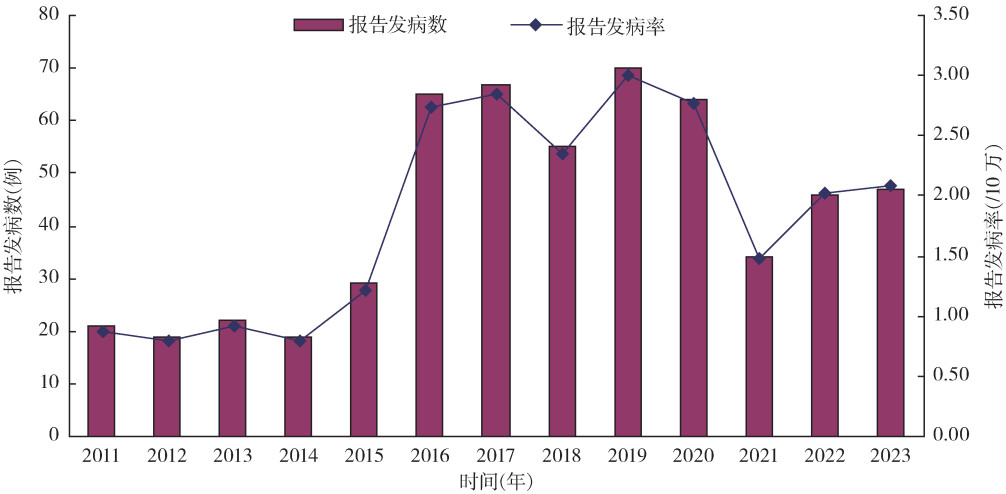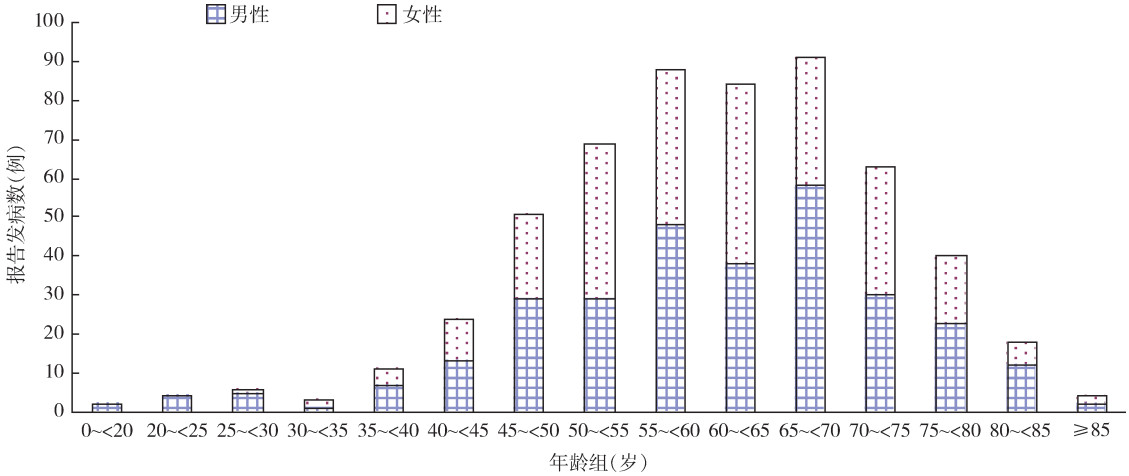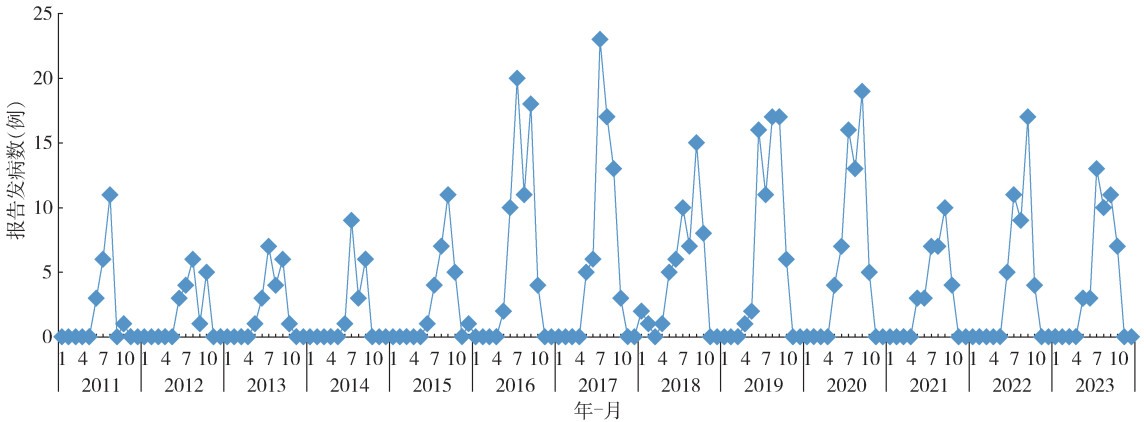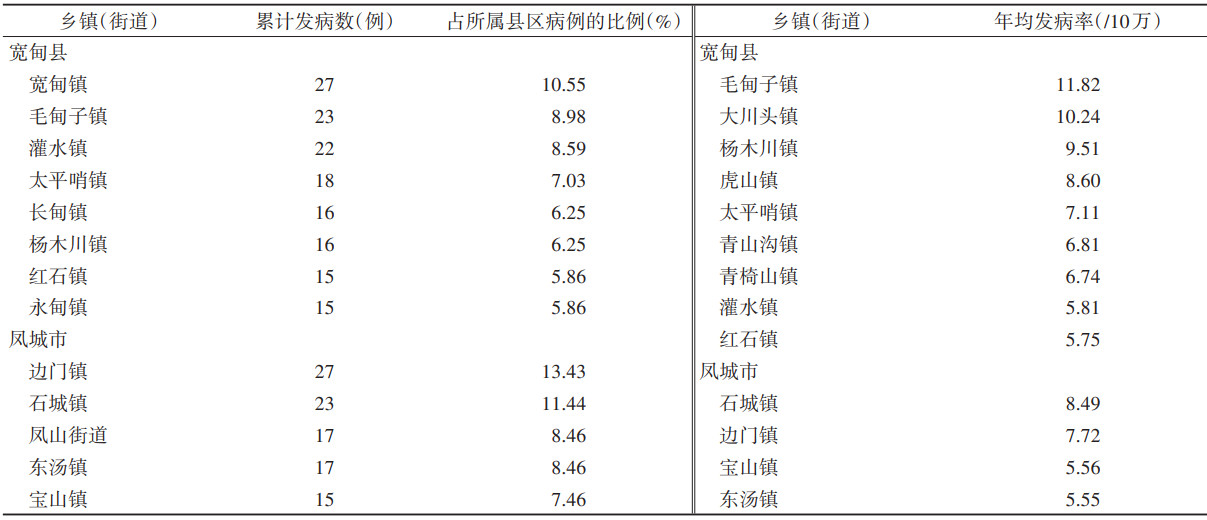扩展功能
文章信息
- 于丹梅, 庞亚男
- YU Dan-mei, PANG Ya-nan
- 辽宁省丹东市2011-2023年发热伴血小板减少综合征流行病学分析
- Epidemiological analysis of severe fever with thrombocytopenia syndrome in Dandong, Liaoning Province, China, 2011-2023
- 中国媒介生物学及控制杂志, 2024, 35(5): 557-563
- Chin J Vector Biol & Control, 2024, 35(5): 557-563
- 10.11853/j.issn.1003.8280.2024.05.009
-
文章历史
- 收稿日期: 2024-05-15
发热伴血小板减少综合征(severe fever with thrombocytopenia syndrome,SFTS)是一种以发热伴血小板减少为主要特征的新发病毒性传染病,主要经蜱叮咬传播[1]。2009年我国学者首次在河南和湖北省的部分病例中分离出其病原体发热伴血小板减少综合征病毒(Severe fever with thrombocytopenia syndrome virus,SFTSV)[2],该病毒现已被国际病毒分类委员会更名为大别班达病毒(Dabie bandavirus,DBV)[3]。2010年,SFTS病因明确后,原国家卫生部发布了《发热伴血小板减少综合征防治指南(2010版)》,并要求参照乙类传染病进行报告和管理[1]。截至2021年底,全国已有27个省份报告SFTS病例,病例报告近2万例[4],病例分布以河南、山东、安徽、湖北、辽宁、浙江和江苏7个省为主[5-6],全国SFTS发病率总体升高、分布范围不断扩散[4, 6]。辽宁省是全国SFTS高发区5省之一[7],而丹东市SFTS发病率居辽宁省首位[8-9],为辽宁省SFTS重点疫区。本研究通过对2011-2023年辽宁省丹东市SFTS病例监测数据进行分析,揭示SFTS的流行特征,为有针对性地制定SFTS防控措施提供科学依据。
1 材料与方法 1.1 数据来源SFTS病例监测数据来源于“中国疾病预防控制信息系统”,统计口径包括:现住址为辽宁省丹东市,发病日期为2011年1月1日(有病例网络报告以来)至2023年12月31日,病例分类为确诊病例和临床诊断病例。人口数据来源于丹东市统计局。
1.2 统计学方法采用Excel 2007软件建立数据库。采用Joinpoint Regression 5.0软件,利用Joinpoint回归模型(JRP模型)对2011-2023年SFTS发病趋势进行分析,并计算年度变化百分比(annual percent change,APC)和平均年度变化百分比(average annual percent change,AAPC),通过若干转折点将研究时间分割成若干区段,进而更详细地评价不同时段内的疾病变化特征。采用SPSS 23.0软件对SFTS疫情概况及流行特征(人群、时间、地区)进行分析,用率或百分比描述计数资料,χ2检验进行率的比较,趋势χ2检验进行发病趋势分析,P < 0.05为差异有统计学意义。
2 结果 2.1 疫情概况2011-2023年,丹东市累计报告SFTS病例共558例,年均报告发病率为1.83/10万,发病率呈整体上升趋势(χ趋势2=51.489,P < 0.001)。见图 1。

|
| 图 1 辽宁省丹东市2011-2023年发热伴血小板减少综合征发病数及发病率情况 Figure 1 Number and incidence of severe fever with thrombocytopenia syndrome in Dandong, Liaoning Province, 2011-2023 |
| |
JRP模型分析显示,2011-2023年丹东市SFTS发病率呈整体上升趋势(AAPC=7.65%,P=0.431),转折点为2014年和2017年。2011-2014年发病率呈缓慢增长趋势(APC=3.97%,P=0.857),2014-2017年发病率呈上升趋势(APC=48.55%,P=0.245),2017-2023年发病率则呈现下降趋势(APC=-6.75%,P=0.178)。
2.2 流行特征 2.2.1 人群分布报告病例中,男性301例,女性257例,男女性别比为1.17∶1。男、女性发病率分别为1.97/10万和1.68/10万,差异无统计学意义(χ2=0.169,P=0.681)。年龄最大89岁,最小12岁,平均年龄(59.98±12.16)岁。发病人群以中老年人为主,45~ < 80岁年龄组累计报告发病数占报告病例总数的87.10%(486例),见图 2。职业构成中,农民占66.85%(373/558),家务及待业占24.19%(135/558),离退人员占3.58%(20/558),其余职业发病人数均 < 10例。

|
| 图 2 辽宁省丹东市2011-2023年发热伴血小板减少综合征年龄分布 Figure 2 Age distribution of severe fever with thrombocytopenia syndrome in Dandong, Liaoning Province, 2011-2023 |
| |
2011-2023年5-10月丹东市共报告病例552例,占报告病例总数的98.92%(552/558)。其中9月发病人数最多,为144例,其次为7月141例,8月122例,7-9月病例数占报告病例总数的72.94%(407/558)。SFTS发病数有5次在7月达到月高峰值,2次在8月达月高峰值,5次在9月达月高峰值,1次为8月和9月高峰值相同。SFTS发病有季节性波动,发病时间分布在5-10月。每年发病数自5月起开始上升,7-9月为发病高峰,每年10月后发病数快速下降,11月至次年4月几乎无病例报告。见图 3。

|
| 图 3 辽宁省丹东市2011-2023年发热伴血小板减少综合征病例发病时间分布 Figure 3 Time distribution of severe fever with thrombocytopenia syndrome in Dandong, Liaoning Province, 2011-2023 |
| |
2011-2023年丹东市6个县(市、区)均有SFTS病例报告,报告发病数和年均发病率位居前2位的县(市、区)均为宽甸满族自治县(宽甸县)(256例,4.70/10万)和凤城市(201例,2.78/10万),其余4个县(市、区)报告发病数和年均发病率分别为振安区25例(1.13/10万),东港市43例(0.56/10万),元宝区13例(0.56/10万)和振兴区20例(0.36/10万)。
2011-2023年全市75个乡镇(街道)有SFTS病例分布,占乡镇总数的83.33%(75/90),病例分布由2011年3个县16个乡镇累计增加到2023年6个县(市、区)75个乡镇(街道),年均发病率 < 1.00/10万的乡镇(街道)有26个,年均发病率在1.00/10万~5.00/10万的有36个,年均发病率 > 5.00/10万的有13个。累计报告病例数位居前5位的乡镇为宽甸县宽甸镇、凤城市边门镇、宽甸县毛甸子镇、凤城市石城镇和宽甸县灌水镇。年均发病率位居前5位的乡镇为宽甸县毛甸子镇、大川头镇、杨木川镇、虎山镇和凤城市石城镇。见表 1。

|
2011-2023年全市SFTS疫情高发区为宽甸县和凤城市,病例分布呈现由北部(宽甸县北部和凤城市北部)中低山区,向中部(凤城市中南部、宽甸县南部、东港市北部)丘陵地带,及中南部(丹东市城区和东港中南部)平原地带扩散的趋势。
2.3 报告单位2011-2023年丹东市558例SFTS病例由14家医疗机构报告,4家省级医疗机构报告109例(19.53%),本省外市3家市级医疗机构报告5例(0.90%),3家本市市级医疗机构报告237例(42.47%),4家本市县级医疗机构报告207例(37.10%),其中宽甸县中心医院报告142例、凤城市中心医院报告62例、东港市第二医院报告2例、东港市传染病医院报告1例。
3 讨论本研究显示,2011-2023年辽宁省丹东市SFTS报告发病率呈整体上升趋势,高于全国[4]和辽宁省[9]平均水平。全市有SFTS病例报告的县(市、区)和乡镇(街道)数量不断增长,病例分布呈现由北部中低山区向中部丘陵地带及中南部平原地带扩散的趋势,与我国多地情况一致[10-16]。
人群分布显示,中老年农民是丹东市SFTS发病的主要人群,男性发病率高于女性、但是差异无统计学意义,与辽宁省数据[7-9]及丹东市既往研究结果[17]一致。性别分布与全国[4]及山东、河南、安徽、湖北4个高发省[7]女性发病率高于男性不一致。可能与农村年轻人多外出务工,而放牧、养蚕、种地、割草等农业生产活动多由留守的中老年男性承担,户外劳作皮肤裸露、劳作时间长、接触蜱虫的机会多及中老年人基础性疾病多、抵抗力弱等有关。
SFTS的发病具有明显的季节性,报告病例主要分布在5-10月,与辽宁省情况一致[9]。7-9月为发病高峰,与丹东市既往研究结果[17]和辽宁省发病情况[7, 9]一致。比山东[11, 18]、河南[19]、江苏[12, 20]、安徽[10, 14, 16]、湖北[21]和浙江省[13, 22]的发病高峰晚1-2个月。丹东市地处北纬40°的中国东北部,属辽宁省长白山地区地理集群,高纬度地区的流行季节和发病高峰较低纬度地区到来的时间延迟[6, 23],可能与丹东市月平均气压、气温、风速等气象因素[9]和蜱密度、季节性消长[24-25]有关。SFTS是一种蜱传自然疫源性疾病,带病毒蜱叮咬吸血是其主要传播方式[26]。长角血蜱(Haemaphysalis longicornis)是我国DBV的主要传播媒介和重要宿主[27-28],又是丹东地区的优势蜱种[29-31],且DBV宿主动物种类广泛[32],山羊和牛是主要的扩散宿主[4]。多地蜱监测表明,长角血蜱的活动自春季开始延续到秋季,存在明显的季节性[33-34],疾病的季节性分布与辽宁省蜱虫的季节消长相吻合[35]。上述对人群和时间分布分析结果显示,5-10月、中老年农民是丹东市SFTS防控的重点时间和人群。
全市SFTS疫情高发区为宽甸县和凤城市,其所辖乡镇(街道)几乎均有病例发生且年均发病率较高。究其原因可能包括以下5个方面:(1)宽甸县和凤城市地处北部,以山地和丘陵地貌为主,属暖温带湿润区大陆性季风气候,光照充足,雨水充沛,森林覆盖率高,为媒介蜱虫的生长繁殖提供了良好的自然条件。(2)辽宁省是全国养牛大省,也是辽宁绒山羊的主产区,宽甸县和凤城市的肉牛和绒山羊饲养业是当地农民增收的主要产业之一,畜牧养殖方式以家庭养殖为主,且近年来牛、羊养殖业稳定增长。有研究表明丹东地区寄生在肉牛和绒山羊体表的长角血蜱的感染率高[36-37],且已有报道在宽甸县牛、羊和犬身上采集到的长角血蜱中检出DBV核酸[30]。牛羊等家畜感染率高,蜱及牛、羊等宿主动物的自然扩散和迁移使新疫区不断形成[4]。(3)当地农民畜牧养殖、养蚕、农作物种植以及野山参、野生菌、板栗采摘等活动增加了户外暴露风险。(4)随着SFTS健康教育的加强和各项防控措施的落实,各县区尤其高发区SFTS诊断和报告能力快速提升,2011-2023年丹东市37.1%的病例由县级医疗机构报告。(5)中朝边境旅游业的发展、自驾游的盛行,使得人群接触山林草丛和被蜱叮咬的机会大大增加。本研究提示,应进一步加强宽甸县和凤城市2个高发地区SFTS的重视程度,在高发乡镇(街道)开展有针对性的监测,落实健康教育策略,增强当地居民个人防护意识。
综上所述,丹东市SFTS发病率呈上升态势,病例分布呈扩散趋势,高发地区的发病率保持在较高水平,SFTS发病率居辽宁省首位。应高度重视SFTS防控工作,建议如下:(1)继续加强传播媒介和宿主动物的监测。(2)针对中老年农民和潜在发病人群做好宣传教育,增强人群自我防护意识、减少暴露风险。(3)在高风险地区改善生态环境以降低蜱密度,做好饲养动物管理。(4)加强培训,提高医务人员诊断和救治能力。
本研究数据来源于“中国疾病预防控制信息系统”中各医疗机构报告的SFTS病例,存在一定局限性。存在部分轻症患者未就诊或未被诊断为SFTS,以及SFTS住院患者出院后死亡的病例未被纳入到传染病监测系统进行统计等情况,可能低估了发病率和死亡率。但是通过连续的监测数据分析,能反映出丹东市SFTS的流行特征,为高发区的SFTS防控提供依据。同时,今后应加强媒介生物分布与季节消长以及DBV带毒情况、人群DBV血清阳性率等调查和研究。
利益冲突 无
| [1] |
中华人民共和国卫生部. 发热伴血小板减少综合征防治指南(2010版)[J]. 中华临床感染病杂志, 2011, 4(4): 193-194. Ministry of Health of the People's Republic of China. Guideline for prevention and treatment of sever fever with thrombocytopenia syndrome (2010 version)[J]. Chin J Clin Infect Dis, 2011, 4(4): 193-194. DOI:10.3760/cma.j.issn.1674-2397.2011.04.001 |
| [2] |
Yu XJ, Liang MF, Zhang SY, et al. Fever with thrombocytopenia associated with a novel Bunyavirus in China[J]. N Engl J Med, 2011, 364(16): 1523-1532. DOI:10.1056/NEJMoa1010095 |
| [3] |
马静阁, 刘宁, 刘紫嫣, 等. 我国致病性蜱媒病毒流行现状[J]. 中国血吸虫病防治杂志, 2023, 35(4): 325-330, 348. Ma JG, Liu N, Liu ZY, et al. Epidemiology of pathogenic tick-borne viruses in China: a review[J]. Chin J Schisto Control, 2023, 35(4): 325-330, 348. DOI:10.16250/j.32.1374.2023128 |
| [4] |
陈秋兰, 朱曼桐, 陈宁, 等. 2011-2021年全国发热伴血小板减少综合征流行特征分析[J]. 中华流行病学杂志, 2022, 43(6): 852-859. Chen QL, Zhu MT, Chen N, et al. Epidemiological characteristics of severe fever with thtrombocytopenia syndrome in China, 2011-2021[J]. Chin J Epidemiol, 2022, 43(6): 852-859. DOI:10.3760/cma.j.cn112338-20220325-00228 |
| [5] |
李佳宸, 王玉娜, 赵静, 等. 发热伴血小板减少综合征流行病学研究进展[J]. 中华流行病学杂志, 2021, 42(12): 2226-2233. Li JC, Wang YN, Zhao J, et al. A review on the epidemiology of severe fever with thrombocytopenia syndrome[J]. Chin J Epidemiol, 2021, 42(12): 2226-2233. DOI:10.3760/cma.j.cn112338-20210529-00439 |
| [6] |
Huang XX, Li JD, Li AQ, et al. Epidemiological characteristics of severe fever with thrombocytopenia syndrome from 2010 to 2019 in Chinese mainland[J]. Int J Environ Res Public Health, 2021, 18(6): 3092. DOI:10.3390/ijerph18063092 |
| [7] |
岳玉娟, 任东升, 鲁亮. 2010-2021年中国发热伴血小板减少综合征流行病学分析[J]. 疾病监测, 2024, 39(7): 824-830. Yue YJ, Ren DS, Lu L. Epidemiological characteristics of severe fever with thrombocytopenia syndrome in China, 2010-2021[J]. Dis Surveill, 2024, 39(7): 824-830. DOI:10.3784/jbjc.202307030309 |
| [8] |
宗莉, 刘学升, 毛玲玲, 等. 辽宁省2011-2017年发热伴血小板减少综合征流行病学特征与M片段基因序列分析[J]. 中国公共卫生, 2019, 35(5): 644-647. Zong L, Liu XS, Mao LL, et al. Prevalence and M-fragment gene sequencing of fever with thrombocytopenia syndrome virus in Liaoning Province, 2011-2017[J]. Chin J Public Health, 2019, 35(5): 644-647. DOI:10.11847/zgggws1121621 |
| [9] |
Wang ZJ, Yang ST, Luo L, et al. Epidemiological characteristics of severe fever with thrombocytopenia syndrome and its relationship with meteorological factors in Liaoning Province, China[J]. Parasit Vectors, 2022, 15(1): 283. DOI:10.1186/s13071-022-05395-4 |
| [10] |
滕雪娇, 邓舒, 赵玉秋, 等. 2011-2022年安徽省发热伴血小板减少综合征流行特征分析[J]. 疾病监测, 2024, 39(1): 48-52. Teng XJ, Deng S, Zhao YQ, et al. Epidemiological characteristics of severe fever with thrombocytopenia syndrome in Anhui, 2011-2022[J]. Dis Surveill, 2024, 39(1): 48-52. DOI:10.3784/jbjc.202304180165 |
| [11] |
段青, 逄博, 张晓梅, 等. 2011-2020年山东省发热伴血小板减少综合征流行特征及空间聚集性[J]. 中华疾病控制杂志, 2022, 26(7): 790-797. Duan Q, Pang B, Zhang XM, et al. Epidemiological characteristics and spatial aggregation of severe fever with thrombocytopenia syndrome in Shandong Province from 2011 to 2020[J]. Chin J Dis Control Prev, 2022, 26(7): 790-797. DOI:10.16462/j.cnki.zhjbkz.2022.07.008 |
| [12] |
Liang SY, Li ZF, Zhang N, et al. Epidemiological and spatiotemporal analysis of severe fever with thrombocytopenia syndrome in eastern China, 2011-2021[J]. BMC Public Health, 2023, 23(1): 508. DOI:10.1186/s12889-023-15379-3 |
| [13] |
Tao MY, Liu Y, Ling F, et al. Severe fever with thrombocytopenia syndrome in southeastern China, 2011-2019[J]. Front Public Health, 2022, 9: 803660. DOI:10.3389/fpubh.2021.803660 |
| [14] |
杨锟, 吴起乐, 赵志荣, 等. 2013-2022年安徽省马鞍山市发热伴血小板减少综合征流行特征及时空聚集性分析[J]. 疾病监测, 2024, 39(7): 831-835. Yang K, Wu QL, Zhao ZR, et al. Epidemiological characteristics and spatiotemporal clustering of severe fever with thrombocytopenia syndrome in Maanshan, Anhui, 2013-2022[J]. Dis Surveill, 2024, 39(7): 831-835. DOI:10.3784/jbjc.202306120279 |
| [15] |
高尚, 赵小冬, 任娅如, 等. 2013-2018年山东省济南市发热伴血小板减少综合征流行特征及时空聚集性分析[J]. 疾病监测, 2019, 34(10): 895-898. Gao S, Zhao XD, Ren YR, et al. Epidemiological characteristics and temporal-spatial clustering analysis on severe fever with thrombocytopenia syndrome in Jinan, 2013-2018[J]. Dis Surveill, 2019, 34(10): 895-898. DOI:10.3784/j.issn.1003-9961.2019.10.008 |
| [16] |
汪金生, 汤厚林, 高伟林, 等. 2011-2016年安徽省安庆市发热伴血小板减少综合征监测分析[J]. 疾病监测, 2018, 33(4): 324-328. Wang JS, Tang HL, Gao WL, et al. Surveillance for severe fever with thrombocytopenia syndrome in Anqing, Anhui, 2011-2016[J]. Dis Surveill, 2018, 33(4): 324-328. DOI:10.3784/j.issn.1003-9961.2018.04.015 |
| [17] |
崔荣敏, 于丹梅, 苗长青, 等. 丹东市2010-2015年发热伴血小板减少综合征流行特征分析[J]. 中国媒介生物学及控制杂志, 2017, 28(1): 60-63. Cui RM, Yu DM, Miao CQ, et al. Analysis of the epidemic characteristics of severe fever with thrombocytopenia syndrome in Dandong city of Liaoning Province, 2010-2015[J]. Chin J Vector Biol Control, 2017, 28(1): 60-63. DOI:10.11853/j.issn.1003.8280.2017.01.016 |
| [18] |
韩璐怿. 山东省发热伴血小板减少综合征的流行特征及其影响因素分析[D]. 济南: 山东大学, 2023. DOI: 10.27272/d.cnki.gshdu.2023.001982. Han LY. Analysis of epidemiological characteristics and influencing factors of severe fever with thrombocytopenia syndrome in Shandong Province[D]. Jinan: Shandong University, 2023. DOI: 10.27272/d.cnki.gshdu.2023.001982.(in Chinese) |
| [19] |
尤爱国, 李懿, 李东晓, 等. 河南省2017-2020年发热伴血小板减少综合征监测分析[J]. 中华流行病学杂志, 2021, 42(11): 2024-2029. You AG, Li Y, Li DX, et al. Surveillance for sever fever with thrombocytopenia syndrome in Henan Province, 2017-2020[J]. Chin J Epidemiol, 2021, 42(11): 2024-2029. DOI:10.3760/cma.j.cn112338-20210426-00345 |
| [20] |
马涛, 张敏, 杜雪飞, 等. 发热伴血小板减少综合征疫情呈上升趋势: 基于2015―2020年南京市报告病例数据[J]. 中华疾病控制杂志, 2022, 26(12): 1407-1413. Ma T, Zhang M, Du XF, et al. The rising trend of severe fever with thrombocytopenia syndrome: Based on the data of reported cases in Nanjing from 2015 to 2020, China[J]. Chin J Dis Control Prev, 2022, 26(12): 1407-1413. DOI:10.16462/j.cnki.zhjbkz.2022.12.008 |
| [21] |
陈琦, 吴杨, 刘漫, 等. 湖北省2016-2021年蜱传传染病流行病学特征分析[J]. 中华流行病学杂志, 2023, 44(7): 1073-1079. Chen Q, Wu Y, Liu M, et al. Epidemiological characteristics of tick-borne infectious diseases in Hubei Province, 2016-2021[J]. Chin J Epidemiol, 2023, 44(7): 1073-1079. DOI:10.3760/cma.j.cn112338-20221009-00866 |
| [22] |
施旭光, 孙继民, 刘营, 等. 2015-2019年浙江省发热伴血小板减少综合征流行特征分析[J]. 疾病监测, 2021, 36(5): 431-435. Shi XG, Sun JM, Liu Y, et al. Epidemiological characteristics of fever with thrombocytopenia syndrome in Zhejiang, 2015-2019[J]. Dis Surveill, 2021, 36(5): 431-435. DOI:10.3784/jbjc.202101070014 |
| [23] |
Miao D, Liu MJ, Wang YX, et al. Epidemiology and ecology of severe fever with thrombocytopenia syndrome in China, 2010‒2018[J]. Clin Infect Dis, 2021, 73(11): e3851-e3858. DOI:10.1093/cid/ciaa1561 |
| [24] |
雷新军, 孔金屏, 熊进峰, 等. 发热伴血小板减少综合征的流行病学特征及其与蜱密度消长的关系[J]. 上海预防医学, 2022, 34(7): 646-649. Lei XJ, Kong JP, Xiong JF, et al. Epidemiological characteristics of severe fever with thrombocytopenia syndrome and association with tick density[J]. Shanghai J Prev Med, 2022, 34(7): 646-649. DOI:10.19428/j.cnki.sjpm.2022.21771 |
| [25] |
吴海霞, 刘小波, 岳玉娟, 等. 2019年全国蜱类监测报告[J]. 中国媒介生物学及控制杂志, 2020, 31(4): 417-422. Wu HX, Liu XB, Yue YJ, et al. National surveillance report on ticks in China, 2019[J]. Chin J Vector Biol Control, 2020, 31(4): 417-422. DOI:10.11853/j.issn.1003.8280.2020.04.007 |
| [26] |
王建跃, 邬辉, 仝振东, 等. 发热伴血小板减少综合征流行病学研究进展[J]. 中华流行病学杂志, 2016, 37(2): 294-298. Wang JY, Wu H, Tong ZD, et al. A review on the epidemiologic features of severe fever with thrombocytopenia syndrome[J]. Chin J Epidemiol, 2016, 37(2): 294-298. DOI:10.3760/cma.j.issn.0254-6450.2016.02.029 |
| [27] |
Luo LM, Zhao L, Wen HL, et al. Haemaphysalis longicornis ticks as reservoir and vector of severe fever with thrombocytopenia syndrome virus in China[J]. Emerg Infect Dis, 2015, 21(10): 1770-1776. DOI:10.3201/eid2110.150126 |
| [28] |
Zhuang L, Sun Y, Cui XM, et al. Transmission of severe fever with thrombocytopenia syndrome virus by Haemaphysalis longicornis ticks, China[J]. Emerg Infect Dis, 2018, 24(5): 868-871. DOI:10.3201/eid2405.151435 |
| [29] |
关浩. 中朝边境地区蜱种及蜱传立克次体的调查研究[D]. 沈阳: 沈阳农业大学, 2019. DOI: 10.27327/d.cnki.gshnu.2019.000376. Guan H. Investigation on tick species and tick-borne Rickettsia inborder areas between China and Korea[D]. Shenyang: Shenyang Agricultural University, 2019. DOI: 10.27327/d.cnki.gshnu.2019.000376.(in Chinese) |
| [30] |
宗莉. 2011-2017年辽宁省发热伴血小板减少综合征流行特征及病原基因型别分析[D]. 大连: 大连医科大学, 2019. Zong L. Epidemiological characteristics and pathogen genotype analysis of SFTS in Liaoning province from 2011 to 2017[D]. Dalian: Dalian Medical University, 2019. DOI: 10.27327/d.cnki.gshnu.2019.000376.(in Chinese) |
| [31] |
于东海. 辽宁省部分地区蜱种分布及携带主要病原的调查研究[D]. 沈阳: 沈阳农业大学, 2020. DOI: 10.27327/d.cnki.gshnu.2020.000923. Yu DH. Investigation on the distribution of ticks and their main pathogens in some areas of Liaoning Province[D]. Shenyang: Shenyang Agricultural University, 2020. DOI: 10.27327/d.cnki.gshnu.2020.000923.(in Chinese) |
| [32] |
Huang XY, Du YH, Wang HF, et al. Prevalence of severe fever with thrombocytopenia syndrome virus in animals in Henan Province, China[J]. Infect Dis Poverty, 2019, 8(1): 56. DOI:10.1186/s40249-019-0569-x |
| [33] |
熊进峰, 占建波, 谭梁飞, 等. 黄冈市蜱及宿主动物携带发热伴血小板减少综合征病毒情况调查[J]. 中国媒介生物学及控制杂志, 2016, 27(5): 504-505. Xiong JF, Zhan JB, Tan LF, et al. Survey on ticks and host animals of severe fever with thrombocytopenia syndrome virus in Huanggang, Hubei Province[J]. Chin J Vector Biol Control, 2016, 27(5): 504-505. DOI:10.11853/j.issn.1003.8280.2016.05.023 |
| [34] |
马婷, 龚震宇, 张严峻, 等. 浙江省发热伴血小板减少综合征布尼亚病毒的宿主媒介调查[J]. 中国媒介生物学及控制杂志, 2015, 26(4): 353-356. Ma T, Gong ZY, Zhang YJ, et al. Survey of vectors and hosts of severe fever with thrombocytopenia syndrome virus in Zhejiang Province, China[J]. Chin J Vector Biol Control, 2015, 26(4): 353-356. DOI:10.11853/j.issn.1003.4692.2015.04.006 |
| [35] |
刘国平, 任清明, 王峰, 等. 东北中朝俄边境地区蜱的生态及防制对策研究[J]. 中华卫生杀虫药械, 2006, 12(3): 208-210. Liu GP, Ren QM, Wang F, et al. Study on ecology and control countermeasures of ticks in frontiers of Russia, Korea and northeast China[J]. Chin J Hyg Insect Equip, 2006, 12(3): 208-210. DOI:10.3969/j.issn.1671-2781.2006.03.017 |
| [36] |
刘孝刚, 张世伟, 于本良, 等. 辽宁绒山羊寄生虫流行区系的调查[J]. 畜牧与兽医, 2011, 43(4): 80-81. Liu XG, Zhang SW, Yu BL, et al. Investigation on endemic area of cashmere goat parasites in Liaoning Province[J]. Anim Hus Vet Med, 2011, 43(4): 80-81. |
| [37] |
刘孝刚, 于迪, 于本良, 等. 辽宁地区肉牛寄生虫流行区系调查[J]. 畜牧与兽医, 2014, 46(2): 85-86. Liu XG, Yu D, Yu BL, et al. Investigation on endemic area of beef cattle parasites in Liaoning region[J]. Anim Hus Vet Med, 2014, 46(2): 85-86. |
 2024, Vol. 35
2024, Vol. 35

